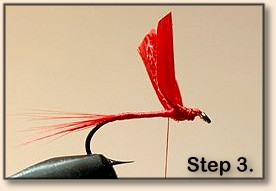 |
 Red Ibis |
|
|
Materials for Red Ibis:
Thread: Red, 6/0. Tail: Red Hackle Fibers. Wing: Red Duck Quill, tied upright and divided. Body: Red Floss. Rib: Gold Tinsel. Hackle: Red Hackle Fibers.
Method for Red Ibis: Step #1: Tie in a good bed of thread. This is important otherwise the floss body will slip and slide on the hook.
 Step #2: Tie in the tail and then advance the thread forward.
 Step #3: Tie in the red duck quill wings.
 Step #4: Run your thread back to the tail and tie in the red floss. Then run your thread forward, then wrap the floss, tying off at the base of the wings.
 Step #5: Run your thread back again, tie in the gold tinsel.
 Step #6: Run your thread forward, wrap your gold tinsel and tie off.
 Step #7: Tie in your hackle, add head cement, lacquer the body.
About Tom: I'm a retired high school science teacher, living in Westland, Michigan.
I've been a hunter, fisherman and outdoorsman my entire life. But, it
wasn't until 1984, that a friend of mine introduced me to the sport of
fly fishing. I got the 'bug' real bad and within a year or two I had
added fly tying and rod building to my list of sportsman's skills.
I'm a retired high school science teacher, living in Westland, Michigan.
I've been a hunter, fisherman and outdoorsman my entire life. But, it
wasn't until 1984, that a friend of mine introduced me to the sport of
fly fishing. I got the 'bug' real bad and within a year or two I had
added fly tying and rod building to my list of sportsman's skills.Although I have fished most of the great rivers in this country, my all time favorite is still, my home river, the Au Sable, here in Michigan. My retirement is now providing me with the time I need to write a little and share with you some of the tips, tricks, patterns and experiences I've had over the years. Stay tuned. See you on the water… ~ Tom Deschaine For more great flies, check out: Beginning Fly Tying, Intermediate Fly Tying and Advanced Fly Tying.
|
[ HOME ]
[ Search ] [ Contact FAOL ] [ Media Kit ]